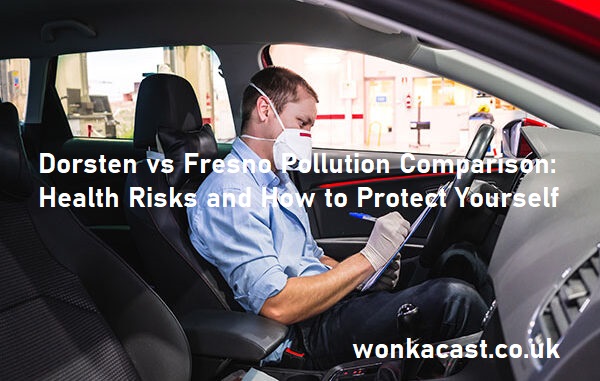Introduction
In recent years, air pollution has become a pressing concern across the globe, affecting both developed and developing nations. Cities like Dorsten in Germany and Fresno in the United States are not exempt from this issue. Understanding the Dorsten vs Fresno Pollution Comparison is essential to grasp how pollution in these two regions affects residents’ health. While both cities face challenges, the nature of pollutants, the sources of pollution, and the health risks vary significantly between them. This guide dives deep into the specific health risks associated with pollution in Dorsten and Fresno, offering practical tips on how to protect yourself and your family from these harmful pollutants.
1. Overview of Air Pollution in Dorsten and Fresno
Air pollution varies by region due to differences in industrial activity, geography, population density, and climate. Dorsten is a small industrial city in North Rhine-Westphalia, surrounded by industrial centers, and pollution here primarily comes from vehicle emissions and nearby industries. In contrast, Fresno, located in California’s San Joaquin Valley, experiences high levels of pollution mainly due to agricultural activities, traffic emissions, and a basin-like geography that traps pollutants.
Key Pollutants in Dorsten
- Nitrogen Dioxide (NO2): Primarily from vehicle exhausts and industrial activities.
- Particulate Matter (PM10 and PM2.5): Produced by traffic, factories, and construction.
- Sulfur Dioxide (SO2): Resulting from industrial operations, such as coal burning.
Key Pollutants in Fresno
- Ozone (O3): Formed when pollutants from vehicles and industries react with sunlight, leading to dangerous smog levels.
- Particulate Matter (PM10 and PM2.5): Similar to Dorsten but also worsened by dust from agriculture and wildfires.
- Pesticides and Agricultural Emissions: Specific to Fresno due to its location in an agricultural hub.
2. Health Risks Associated with Pollution in Dorsten
Living in Dorsten exposes residents to long-term health risks, primarily from fine particulate matter and NO2, which are prevalent due to traffic and industrial activities. Prolonged exposure can lead to:
- Respiratory Diseases: Increased cases of asthma, chronic bronchitis, and decreased lung function, especially in children and the elderly.
- Cardiovascular Diseases: Exposure to high levels of NO2 and particulate matter can elevate the risk of heart attacks and strokes.
- Cancer: Studies have linked long-term exposure to pollutants like PM2.5 to lung cancer.
3. Health Risks Associated with Pollution in Fresno
Fresno’s air quality is among the poorest in the United States due to its geography, which traps pollutants. Health risks here include:
- Asthma and Respiratory Illnesses: Fresno has some of the highest asthma rates in the U.S., primarily due to elevated ozone and particulate matter levels.
- Chronic Obstructive Pulmonary Disease (COPD): High pollution levels increase COPD cases, which cause breathing difficulties and other lung problems.
- Premature Death: Studies indicate a correlation between long-term exposure to Fresno’s pollution and premature deaths due to heart disease, respiratory issues, and stroke.

wonkacast.co.uk
4. Differences in Vulnerable Populations
In both Dorsten and Fresno, the impact of air pollution is particularly harsh on certain groups, including:
- Children: Their developing respiratory systems make them more susceptible to pollution-induced asthma and lung damage.
- Elderly: Older adults in both cities are at higher risk of developing cardiovascular and respiratory issues due to prolonged pollution exposure.
- People with Preexisting Conditions: Those with asthma, COPD, or heart conditions face exacerbated symptoms when exposed to high pollution levels.
5. Air Quality Monitoring Systems in Dorsten vs Fresno
Both cities have established systems to monitor and report air quality, though the focus and technologies vary.
- Dorsten uses local air quality monitoring stations that focus on industrial and vehicular emissions. Public health initiatives are also active in reducing exposure to these pollutants.
- Fresno relies on a state-wide network of air quality monitors, including the Air Quality Index (AQI), which regularly reports on pollution levels, particularly smog and particulate matter. Fresno’s AQI often reaches unhealthy levels, especially during wildfire season.
6. How to Protect Yourself in Dorsten
Residents of Dorsten can take several proactive measures to reduce their exposure to harmful pollutants:
- Monitor Air Quality Reports: Stay updated on pollution levels through local apps and websites. Avoid outdoor activities during high pollution days.
- Ventilate Indoors: Use air purifiers at home to remove indoor pollutants, especially on days with poor outdoor air quality.
- Wear Protective Masks: On days with high particulate matter, consider wearing N95 masks when going outside, especially if you’re near high-traffic areas or industrial zones.
7. How to Protect Yourself in Fresno
Given the higher pollution levels in Fresno, residents should be particularly vigilant in protecting their health:
- Check the AQI Daily: Fresno’s air quality can vary greatly depending on the season and weather patterns. Avoid outdoor activities when the AQI is poor.
- Reduce Exposure to Agricultural Pollutants: Limit time spent near farmland or use air filtration systems at home.
- Stay Indoors During Wildfires: Fresno is prone to seasonal wildfires, which significantly worsen air quality. During these times, keep windows closed and use air purifiers.
8. Reducing Pollution Exposure for Families in Both Cities
Families in both Dorsten and Fresno can take these steps to minimize health risks from pollution:
- Install HEPA Air Filters: Use high-quality air filters to purify indoor air, especially in children’s bedrooms and living areas.
- Exercise Indoors: On days when air pollution levels are high, move physical activities indoors to reduce inhalation of pollutants.
- Limit Car Use: Encourage the use of bicycles or public transport to reduce vehicular emissions in Dorsten. In Fresno, carpooling can also minimize traffic-related pollution.
9. Seasonal Variations in Air Pollution
Both Dorsten and Fresno experience fluctuations in pollution levels throughout the year, influenced by weather patterns, temperature changes, and seasonal activities.
- Dorsten: During winter, air pollution tends to spike due to increased heating demands and vehicle use. Industrial emissions are often higher due to increased production cycles, while cold air traps pollutants close to the ground.
- Fresno: Pollution in Fresno worsens in summer, especially due to ground-level ozone, which forms more easily in high temperatures. Wildfires, which are common in California during late summer and fall, also contribute to elevated particulate matter and other pollutants, leading to hazardous air quality.
10. Government Regulations and Pollution Control Initiatives
Both Dorsten and Fresno have government regulations in place aimed at reducing pollution, although the approaches differ based on regional priorities.
- Dorsten: Germany enforces strict EU air quality standards to limit emissions of NO2, PM10, and other pollutants. The government has encouraged the adoption of cleaner technologies and low-emission zones, especially in industrial areas.
- Fresno: The California Air Resources Board (CARB) sets stringent air quality standards in the state, focusing on reducing emissions from vehicles, agriculture, and industry. Fresno also receives funding for initiatives such as clean vehicle programs and air quality monitoring improvements to tackle pollution.
11. Impact of Traffic Congestion on Air Quality
Traffic congestion is a significant contributor to pollution in both Dorsten and Fresno. However, the sources of traffic-related pollution differ slightly between the two cities.
- Dorsten: Heavy reliance on cars for commuting and transportation leads to higher NO2 levels from diesel engines. Emissions from delivery trucks in industrial zones further exacerbate pollution in certain areas.
- Fresno: In Fresno, agricultural transport vehicles, such as trucks used for shipping produce, are major contributors to pollution. Congested highways and busy intersections worsen traffic-related emissions, and with the city located in a valley, pollutants from vehicles remain trapped close to the ground.

wonkacast.co.uk
12. Public Health Policies and Community Awareness Programs
Efforts to mitigate the impact of pollution on public health involve both regulatory measures and public awareness campaigns.
- Dorsten: Public health initiatives in Dorsten focus on educating residents about the risks of air pollution, especially vulnerable populations like children and the elderly. Local campaigns encourage using public transportation, reducing car usage, and improving energy efficiency in homes.
- Fresno: Fresno has launched several community outreach programs to raise awareness about the health risks of air pollution, particularly during wildfire season. Organizations work with schools, hospitals, and local authorities to provide resources like air quality alerts, tips on avoiding pollution exposure, and assistance with access to clean air solutions, such as HEPA air filters.
13. Long-Term Solutions for Reducing Air Pollution in Both Cities
Looking ahead, both Dorsten and Fresno are exploring long-term solutions to reduce pollution and improve air quality.
- Dorsten: The city is working on increasing the use of renewable energy sources, such as wind and solar power, to reduce industrial and residential dependence on fossil fuels. Additionally, smart city technologies are being integrated to monitor air quality in real-time and optimize traffic flow to reduce congestion.
- Fresno: Fresno is focusing on sustainable agricultural practices to reduce emissions from farming, including adopting carbon sequestration techniques and using cleaner machinery. The city is also encouraging the adoption of electric vehicles and expanding public transportation to reduce emissions from traffic.
Conclusion
Understanding the Dorsten vs Fresno Pollution Comparison is crucial for residents looking to protect their health. While both cities face distinct challenges—Dorsten from industrial pollutants and Fresno from agricultural and wildfire-related emissions—there are practical steps residents can take to minimize exposure. Monitoring air quality, using protective equipment, and making lifestyle changes can significantly reduce the health risks posed by air pollution. By staying informed and proactive, you can safeguard your family’s well-being against the harmful effects of pollution.
FAQs about Dorsten vs Fresno Pollution Comparison
1. What are the primary sources of pollution in Dorsten?
The main sources of pollution in Dorsten are vehicle emissions, industrial activities, and construction dust.
2. Why is Fresno’s air quality worse during wildfire season?
Wildfires release massive amounts of particulate matter into the air, significantly worsening Fresno’s already poor air quality.
3. How can I reduce my exposure to pollution in Dorsten?
You can reduce exposure by monitoring air quality reports, using air purifiers indoors, and avoiding outdoor activities during high pollution days.
4. Is it safe to exercise outdoors in Fresno?
It is safe to exercise outdoors when the AQI is good, but avoid outdoor activities when the AQI shows unhealthy pollution levels, especially during wildfire season.
5. What health problems are caused by long-term exposure to pollution in both cities?
Long-term exposure to air pollution can cause respiratory diseases, cardiovascular issues, asthma, and in severe cases, increase the risk of lung cancer.





